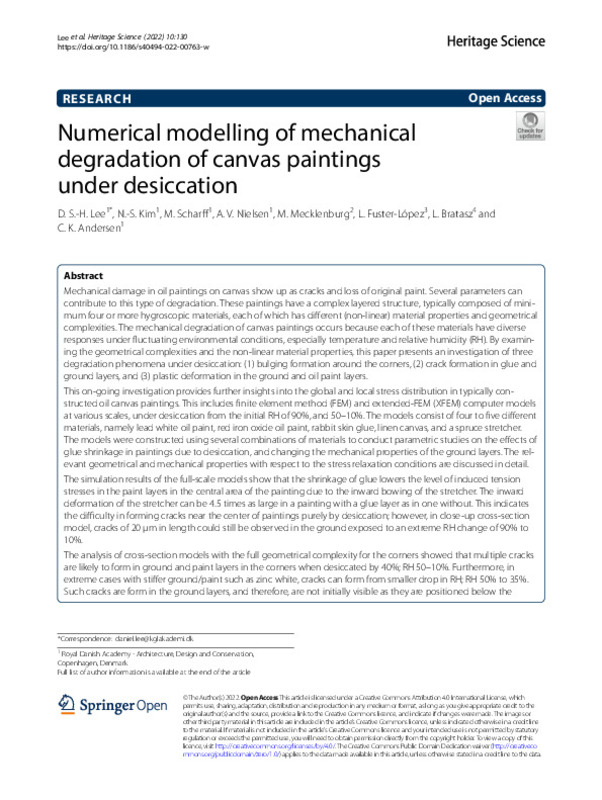Stout GL. A trial index of laminal disruption. J Am Inst Conserv. 1977;17(1):17–26.
Bucklow S. The description of craquelure patterns. Stud Conserv. 1997;42:129.
Roche A. Influence du type de chassis sur le vieillissement mecanique d’une peinture sur toile. Stud Conserv. 1993;38(1):17–24.
[+]
Stout GL. A trial index of laminal disruption. J Am Inst Conserv. 1977;17(1):17–26.
Bucklow S. The description of craquelure patterns. Stud Conserv. 1997;42:129.
Roche A. Influence du type de chassis sur le vieillissement mecanique d’une peinture sur toile. Stud Conserv. 1993;38(1):17–24.
Padfield T, et al. Back protection of canvas paintings. Heritage Science. 2020;8(1):96.
Mecklenburg MF. Micro Climates and Moisture Induced Damage to Paintings. in Conference on Micro Climates in Museum. 2007. Copenhagen.
Erhardt D, Tumosa CS, Mecklenburg MF. Applying science to the question of museum climate. in Conference on Micro Climates in Museum. 2007. Copenhagen.
S Rehbein, M Huisgen, Modellversuche zu Grundierungstechniken der Leinwandgemälde im 19. Jahrhundert, in Das 19. Jahrhundert und die Restaurierung: Beiträge zur Malerei, Maltechnik und Konservierung H. Althöfer, Editor. 1987, Callwey. p. 255–260.
Bilson T. Canvas Shrinkage: A Preliminary Investigation into the Response of a Woven Structure. in ICOM Committee for Conservation, 11th Triennial Meeting. 1996. Edinburgh.
Andersen CK, et al. The industrialisation of canvas production in Denmark and its implications for the preservation of Danish nineteenth century paintings. in Incredible Industri : Preserving the evidence of industrial society. 2009. Copenhagen
Karpowicz A. In-plane deformations of films of size on paintings in the glass transition region. Stud Conserv. 1989;34(2):67–74.
Keck S. Mechanical alteration of the paint film. Stud Conserv. 1969;14(1):9–30.
Giorgiutti-Dauphiné F, Pauchard L. Painting cracks: a way to investigate the pictorial matter. J Appl Phys. 2016;120(6): 065107.
Flores JC. Mean-field crack networks on desiccated films and their applications: girl with a pearl earring. Soft Matter. 2017;13(7):1352–6.
Mecklenburg MF. Determining the Acceptable Ranges of Relative Humidity And Temperature in Museums and Galleries: Part 1, Structural Response to Relative Humidity. 2007.
ASHRAE handbook: heating, ventilating, and air-conditioning applications: Chapter 24 museums, galleries, archives, and libraries. 2019: American Society of Heating, Refrigerating and Air-Conditioning Engineers.
Michalski S. The power of history in the analysis of collection vulnerabilities. in ICOM Committee for Conservation 17th Triennial Meeting. Melbourne. 2014.
Mecklenburg MF, Tumosa CS. Mechanical Behavior of Paintings Subjected to Changes in Temperature and Relative Humidity. in Art in Transit: Studies in the Transport of Paintings. Washington D.C. 1991
Mecklenburg MF, McCormick-Goodhart M, Tumosa CS. Investigation into the deterioration of paintings, and photographs using computerized modeling of stress development. J Am Inst Conserv. 1994;33(2):153–70.
Mecklenburg MF, Tumosa CS, McCormick-Goodhart MH. A general model relating externally applied forces to environmentally induced stresses in materials. MRS Proc. 1995;352:285.
de Willigen P. A mathematical study on craquelure and other mechanical damage in paintings. Delft: Delft University Press; 1999.
Vila A, et al. Picasso 1917: An insight into the effects of ground and canvas in the failure mechanisms in four artworks. In conservation of modern oil paintings. Amsterdam: Springer; 2020.
Witlox M, Carlyle L. A perfect ground is the very soul of the art’ (Kingston 1835): ground recipes for oil painting, 1600–1900. In ICOM Committee for conservation 14th triennial meeting the Hague 12–16 September 2005. Hague: James & James/Earthscan; 2005.
van Driel BA, et al. The white of the 20th century: an explorative survey into Dutch modern art collections. Herit Sci. 2018;6(1):16.
Mecklenburg MF, Tumosa CS, Mecklenburg MF. Mechanical behavior of paintings subjected to changes in temperature and relative humidity in Art In Transit: studies in the transport of paintings. London: National Gallery of Art; 1991. p. 173–216.
Mirianon F, Fortino S, Toratti T. A method to model wood by using ABAQUS finite element software. Part 2. application to dowel type connections. Espoo: VTT Publications; 2008.
Rachwal B, et al. Response of wood supports in panel paintings subjected to changing climate conditions. Strain An Int J Exp Mech. 2012;48(5):366–74.
Stevens WC. Rates of change in the dimensions and moisture contents of wooden panels resulting from changes in the ambient air conditions. Stud Conserv. 1961;6(1):21–5.
Dassault Systèmes Simulia Corp. Abaqus Theory Guide. 2018.
Mecklenburg MF, Tumosa CS, Erhardt D. The changing mechanical properties of aging oil paints. In Materials Research Society Symposium. Warrendale: Materials Research Society; 2005.
Scharff M, Andersen CK, Filtenborg T. Canvas-related micro-cracks in Danish 19th century paintings. in ICOM-CC Triennial Conference in Beijing: Transcending Boundaries: Integrated Approaches to Conservation, 2021. Beijing.
Filtenborg T, Andersen CK. Canvas supports and grounds in paintings by C.W. Eckersberg. Paper presented at Technology & Practice: Studying the European Visual Arts 1800-1850 – Paintings, Sculpture, Interiors and art on Paper, 2016. Copenhagen.
Andersen CK. Lined canvas paintings. Mechanical properties and structural response to fluctuating relative humidity, exemplified by the collection of Danish Golden Age paintings at Statens Museum for Kunst (SMK). PhD Thesis, KADK Royal Danish Academy of Fine Arts, Schools for Architecture, Design and Conservation, School of Conservation. 2013
Pernety AJ. Dictionnaire portatif de Peinture, Sculpture et Gravure: avec un traité pratique des différentes manières de peindre, chez Bauche. 1757.
[-]









